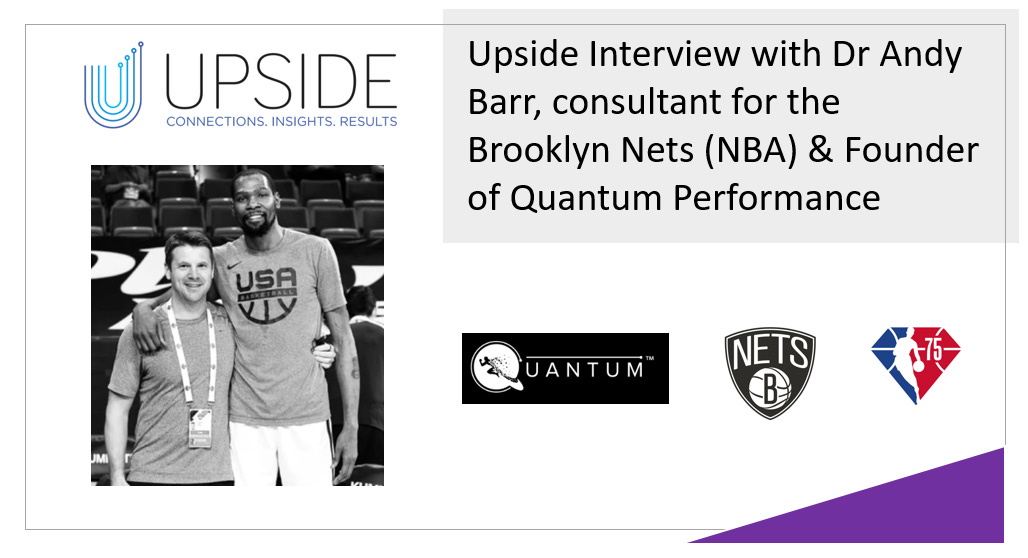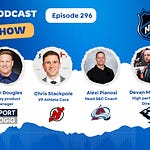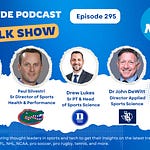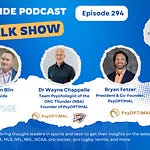This week we had the honor to interview again a group of sports performance experts.
Pierre Barrieu, an experienced high performance director in the MLS (LA Galaxy, LAFC, Toronto FC, NY Red Bulls, etc.), Premier League (Leeds United FC) and FIFA expert.
Dr Derek Lawrance, Assistant Athletic Trainer, U.S. Men’s Soccer National Team.
Dr Bill Burgos, an experienced NBA Strength &Conditioning coach. He has worked for many NBA teams (Orlando Magic, NY Knicks, Timberloves..). He is also an adjunct professor at Mississippi state and Austin Peay State university.
Dr. Marco Nunez, Former Head Athletic Trainer, LA Lakers (NBA) .
Adam Quigley, an experienced athletic trainer in the MLS (LA Galaxy), NFL (Saints) & US Soccer national teams.
📝Show Notes: Through this interview, we touched on the KPIs in sports, and what makes a good manager in a team setting. We also touched on the best teams they worked for. We also discussed Orlando City SC (MLS), where they build reliable processes to capture the data and became data centric. Lastly we discussed the fact that Messi won his 8th ballon d’or.
🚀Best Quotes: Here are some of the key discussion points and best quotes from our conversation with Adam, Pierre, Marco, Bill, and Derek:
On the best KPIs they used within a team setting:
Pierre Barrieu:
“The list of KPIs goes on and on and on . So what I would say is that it depends. If you are managing the high performance department, the KPIs that you have to agree on, has to be done in common with the people on your team. You don't want to dictate to one of your practitioners the exact method they should use. There should always be a leeway. So on the medical side, we can talk about a range of motion, active and passive range of motion, especially now with all the tools coming with the kinetics and so forth”.
“On the physical side, in soccer, we look at the classic ones, the spring distance, the running amount, and the high speed running. In clubs the thresholds are pretty much universal, but in some clubs, there was a different threshold, which was very interesting because it was hard to compare with other clubs”.
“And then obviously the AC ratio, and the deeper analytical type of KPI that we can discuss. So in soccer, it's mostly about running. And I would say that there's a much bigger commonality on the medical side from sport to sport”.
“We've had physical team goals where you want to outright your position, and when you're setting standards based on your players’ profiles and what you think you should achieve in a game in order to be successful. So we've had that in pretty much all my clubs. But again, this is pretty much the head coach call most of the time”.
Dr Bill Burgos:
“So basically, in the NBA, we had this AMS platform called Kinduct at the time. So when we had Kinduct, you had your athlete who had an overall score out of let’s say 100”.
“And so what we did was, that we basically created four categories. It was performance, strength, things that we thought of value, body fat and movement. And this incorporated the whole high performance team where the athletic trainer and physical therapy, because we all had our own tests”.
“If you ever read the book called the four disciplines of execution by Chris McChesney and Sean Covey, they talk about no more than 2 to 3 goals. Each department should have no more than 2 to 3 goals. So what we decided to do was in the performance side, that was more about our sports science, our force plate numbers, our wearables”.
“And then we broke down those two items, and then it was two items on each one. So for wearables, what are we looking for? Heart rate load. And for force play, what are we looking for? RSIs and things like that. So then, for the body fat segment, we worked with our dieticians and then we'll have our body fat numbers”.
“But I also worked with our chefs. We gave this number where it was 01012. So zero. So they had a sheet. And basically, if the player didn't go to the player's lounge to eat, they would get a zero. If they ate, but they didn't eat at the right time, they would get a one. And so what we did was that we created this whole system based off of what we wanted to measure”.
“And then we created these key performance indicators that alerted us. And then those KPIs should be within these ranges. And that's how we measure them throughout the whole process. So, for example. If out of 100, let's say this guy's a 70, for example, it would alert us, then we would break down what's great. What's making it a 70. Is it the performance side? The movement side? Is it the strength side? The strength side is like things that we measured whatever our big lists was in weight room attendance”.
“And so whatever those numbers were that brought that 70 down, whatever that that led to that certain segment, we would focus on that area and it helped us really focus on what area we needed to improve on, whether it was body fat, nutrition, whatever it is to help keep those KPIs up in that sense. And that's how we used the athlete management system (AMS) where we broke it down into four different segments that incorporate everybody and everybody would put in their own KPIs based off what we're trying to measure’.
Dr Marco Nunez:
“As Pierre mentioned, sometimes the coaches dictate, or the director of sports medicine will dictate how you do it and what you want to measure but everybody is different. And just because they worked for one team. And I think that's one of the downsides of a lot of teams see and say is that, well, if they're using Kinduct, and they just won the championship with Kinduct, we have to go by Kinduct. But that's not the way it works”.
“I would think that everybody's completely different. And I think that's what a lot of teams fail to do is to analyze. Hey, what do we need? What's going to help us? Do we have a staff to do it? Some teams may not have a nutritionist in the kitchen to be able to categorize. I think that now most of the teams have a nutritionist. Ultimately all this has to be individualized and customized for teams and players”.
“As Bill mentioned, the KPIs are for you as an individual to give you feedback on whether what you're doing is working or not. (…) These are just feedback for us to either justify that what we're doing is succeeding or not”.
Adam Quigley:
“I think APIs are what develop structure, and create a perspective and lens that we can view and make decisions from that. We can evaluate and analyze from there. As everyone touched on the categories or the levels of KPIs, there's a larger principle plan as far as a club organization. There are the coaches and the KPIs of we want to score like being in the top 3 in the league in terms of goals or whatever it is”.
“And those KPIs obviously that are a little less involved goals. For example on the medical performance side, but even a KPI like being in the top three in league and goals, well, how do we score goals? Okay. We score goals by getting in behind the defense. How do we do that? It's sprint speed agility. And so then from a medical, it's okay. Hamstring health”.
“And so with those things, we can look at those KPIs from a global perspective and then funnel them and divide into what we can actually do day to day, which then becomes that sub API level for our things. And it does end up being individualized to ourselves as a department, as well as ourselves as an individual and our staff and how do we align our own KPIs as far as our own role responsibilities to align within those”.
On what makes a good manager in a team setting:
Adam Quigley::
“It depends on the environment, but first and foremost, a good manager has to be a clear communicator. You have to understand what you're trying to communicate, why you're communicating and when you're communicating these things”.
“When I think about what didn't work well and how that could have shifted, it's also for me to create an environment where people are rated and inspired to work amongst each other and work with each other to not put up walls, but to create less of a silent, more of a cohesive integrated working realm. And the last part, which is probably the most important, it is to have a coach or manager that is true to their word. When the coach or manager is true to their word it creates a sense of self confidence”.
Dr Marco Nunez:
“The two things that are top of mind as far as the manager is one, the communication, which is probably the number one thing, as Adam mentioned, but the two things that I think, going back to when I was the director (At the LA Lakers/NBA) were one, as far as the manager, understanding my limitations and understanding that the people that I worked with, or I've hired or around me, I need to trust the people I hired”.
“I'm not a big micromanager person. I just have this belief as if I'm the manager and I'm micromanaging everybody, they either tell me one or two things either one, I don't trust who I hired. Then the question is, well, why do I have them as part of my staff? I don't trust them in a sense”.
“I used to have people come up to me and tell me “hey, we're going to do this”. And I would tell them “Hey, I hired you for a reason. I trust you and what you're doing. Go do your thing. If you need my help, then we need sit down and communicate and that's fine. But you don't have to keep asking me every question”.
“So understanding as a manager, my own limitations and understanding that “Okay, why do I have these people around me? Why do I have this support system? Why do I have this citation? Why do I have this strength coach? So it is important to trust them”.
Dr Bill Burgos:
“I agree with Marco. There are 3 things for me that are important. One, the biggest thing is to treat people with respect. I don't care if you know everything or you hired me to do this, if you're going to treat me like garbage, I'm not going to want to work with you. And why?”.
“Because I know there's a lot of studies that show out there that. They have a thing. It's called quiet quitting. People would just do and just get by. And you don't want that from an employee or somebody on your staff, especially as it would diminish the quality of training that these players will receive because you're only going to get just enough out this guy because he's not motivated because you treated him with this respect”.
“And even though you hired him to do these things, and if he's not treated the right way, he's not going to give you a hundred percent. Number two is being a good communicator. Like what you're saying, Adam, I just think that if you're not clear with what you're saying and then you get mad because I didn't do it this way or this and that, I think that could lead to a lot of problems”.
“Let that person do their thing. You hired him for a reason and let him grow. That's the only way they can move. The idea is for them not to be your assistant or disposition for a long period of time. They want to grow and you have to give them that opportunity while they do their job because I think they would give a lot for you”.
Pierre Barrieu:
“If you're good manager, I think you should surround yourself with probably smarter people than yourself, and then empower them, and you delegate going back to my KPI points. But they also have to be aware that at times, the consensus is great in theory, but it doesn't always happen, and then you will make that call”.
“And going back to what Bill was saying, number one, treat people with respect. And then they would have to respect the decision, which would be even more so easier if, again, they know that you lead by example, which is if he/she leads by example, you should have respect, you're a good listener, and then you can expect the same from other people, from your staff. So for me, it's more about being a leader and being a leader means, that they're good at what they do. This is why they're in the position that they're at”.
Dr Derek Lawrance:
“A good manager is a good manager of the people, a good people person that understands the roles of everybody and that has a little bit of insight into each of their roles, maybe not an expert in every single role, but just also someone that has a lot of trust in the people that they hire below them, because ultimately there are going to be times that they're going to be autonomous and doing things that you're not always going to be around for”.
“But as long as you have that trust in them, and you give them that freedom and empower them to make them feel like they are part of the process or part of the projects. Then I think that's going to be one of the major goals of or big pieces of a good manager”.
You may also like:
🔥Upside Chat with Top Sports Performance Execs (MLS, NHL, Premier League) on Cryochambers, Cooling/Heating Therapy, Serena, and more.
This week we had the honor to interview a group of sports performance experts. Pierre Barrieu, Head Fitness coach & Performance analyst at Leeds United FC (Premier League) Karam Al-Hamdani, Head Athletic Therapist at CF Montreal (MLS). Alexi Pianosi, Strength and conditioning coach for the Pittsburgh Penguins (NHL).
🔥 Upside Chat: Dr Andy Barr, Consultant, Brooklyn Nets (NBA) & Quantum Performance Founder
This week, we had the honor to interview Dr Andy Barr, consultant for the Brooklyn Nets, a top NBA team. Andy is also the Founder of Quantum Performance and previously worked for the NY Knicks in the NBA, NYFC in the MLS, Manchester City, the Saints, Bolton in the Premier League.
🔥 Upside Chat: Dave Hancock, CEO, Apollo (Leading Athlete Management Systems (AMS) vendor)
🔥 Upside Chat: Ismael Fernandez, ThermoHuman CEO
🔥Upside: AMS Ecosystem Analysis: Key Trends, Vendors and Recommendations to Teams
💦Upside Analysis: The sweat and heat sensing market (Key Trends, Vendors)













